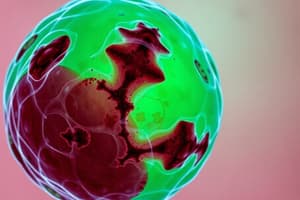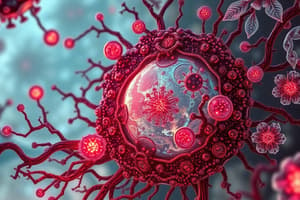Podcast
Questions and Answers
What is the term used to describe reversible cell injury characterized by functional and structural changes in cells that are not permanent?
What is the term used to describe reversible cell injury characterized by functional and structural changes in cells that are not permanent?
Reversible injury
What is the term for the alterations that enable cells to cope with stresses without damage?
What is the term for the alterations that enable cells to cope with stresses without damage?
Adaptations
Cells can either recover from stress-induced injuries or be irreversibly damaged and die.
Cells can either recover from stress-induced injuries or be irreversibly damaged and die.
True (A)
What are the two major pathways of cell death?
What are the two major pathways of cell death?
Which category does aging fall into with regards to cell injury?
Which category does aging fall into with regards to cell injury?
What is the result of cell injury in the absence of repair?
What is the result of cell injury in the absence of repair?
What is the difference between necrosis and apoptosis?
What is the difference between necrosis and apoptosis?
The _______________________ of a cell is characterized by swelling of the endoplasmic reticulum and mitochondria.
The _______________________ of a cell is characterized by swelling of the endoplasmic reticulum and mitochondria.
Necrosis is a controlled and regulated process.
Necrosis is a controlled and regulated process.
What is apoptosis?
What is apoptosis?
Match the following types of cell injury with their corresponding descriptions:
Match the following types of cell injury with their corresponding descriptions:
What is the main cause of necrosis?
What is the main cause of necrosis?
In apoptosis, cells are eliminated because they are beyond repair.
In apoptosis, cells are eliminated because they are beyond repair.
Coagulative necrosis preserves cell outlines due to ______________ damage.
Coagulative necrosis preserves cell outlines due to ______________ damage.
Which process is characterized by the inability to restore mitochondrial function and is often a regulated cell death?
Which process is characterized by the inability to restore mitochondrial function and is often a regulated cell death?
Necrosis is always a pathologic process resulting from severe injury.
Necrosis is always a pathologic process resulting from severe injury.
Necrosis is the result of _______ injury and is a pathologic process.
Necrosis is the result of _______ injury and is a pathologic process.
Name the two pathways of apoptosis mentioned in the text.
Name the two pathways of apoptosis mentioned in the text.
What are caspases?
What are caspases?
BCL-2 is an oncogene.
BCL-2 is an oncogene.
The ____ pathway is also known as the intrinsic pathway of apoptosis.
The ____ pathway is also known as the intrinsic pathway of apoptosis.
What is the process in which enzymes are activated by specific signals to dismantle the nucleus and cytoplasm, generating fragments that are recognized and rapidly cleared by phagocytes?
What is the process in which enzymes are activated by specific signals to dismantle the nucleus and cytoplasm, generating fragments that are recognized and rapidly cleared by phagocytes?
Which of the following conditions is associated with apoptosis? (Select all that apply)
Which of the following conditions is associated with apoptosis? (Select all that apply)
Physiological apoptosis can occur during embryogenesis?
Physiological apoptosis can occur during embryogenesis?
______ pathway seems to be responsible for apoptosis in most physiological and pathologic situations.
______ pathway seems to be responsible for apoptosis in most physiological and pathologic situations.
Flashcards are hidden until you start studying
Study Notes
Cell Injury and Death
- Cell injury can be reversible or irreversible, and may lead to cell death
- Cells can adapt to stress, recover, or die in response to injury
- Causes of cell injury include:
- Infectious pathogens producing toxins
- Hypoxia and ischemia
- Toxins and medications
- Environmental insults (e.g. radiation, trauma)
- Genetic abnormalities
- Immune reactions
- Aging
- Reversible cell injury is characterized by:
- Functional and structural changes
- No permanent damage
- Can be corrected if the injurious agent is removed
- Examples: swelling of endoplasmic reticulum and mitochondria, breakdown of plasma membrane
Mechanisms of Cell Injury and Death
- Reversible cell injury can progress to irreversible injury and cell death
- Irreversible cell injury is characterized by:
- Permanent damage
- Unable to be corrected
- Leads to cell death
- Examples: breakdown of nucleus, leakage of contents
- Two major pathways of cell death:
- Necrosis: unprogrammed cell death, characterized by:
- Inflammation
- Cellular fragments
- Phagocytosis of apoptotic cells
- Apoptosis: programmed cell death, characterized by:
- Condensation of chromatin
- Membrane blebs
- Apoptotic bodies
- Phagocytosis of apoptotic cells
- Necrosis: unprogrammed cell death, characterized by:
Cellular Adaptations to Stress
- Cells can adapt to stress through:
- Changes in cellular function
- Changes in cellular structure
- Increased production of certain proteins
- Activation of cellular defenses
- Changes in gene expression
Pathologic Accumulations in Cells
- Fatty change: accumulation of triglycerides in cells
- Eosinophilia: accumulation of eosinophilic proteins in cells
Endoplasmic Reticulum (ER) Stress
- ER stress: disruption of ER function
- Causes: hypoxia, toxins, genetic abnormalities
- Results: accumulation of misfolded proteins, activation of cellular defenses### Cell Injury and Cell Death
Reversible Cell Injury
- Characterized by a sequence of events that can lead to necrosis or apoptosis
- Cell injury can be caused by various factors, including ischemia, toxins, and physical injury
- The injury can be reversible if the cell is able to repair itself
Necrosis
- A pathologic process that results in cell death
- Characterized by cellular swelling, disruption of plasma membrane, and leakage of cellular contents
- Can cause local inflammation and release of enzymes that break down cellular components
- Examples of necrosis include:
- Coagulative necrosis (e.g., heart attack, stroke)
- Liquifactive necrosis (e.g., bacterial infections)
- Caseous necrosis (e.g., tuberculosis)
- Fat necrosis (e.g., acute pancreatitis)
- Fibrinoid necrosis (e.g., immune reactions)
Apoptosis
- A regulated process of cell death
- Characterized by cell shrinkage, fragmentation of DNA, and formation of apoptotic bodies
- Apoptotic cells are typically engulfed by macrophages and removed
- Examples of apoptosis include:
- Physiologic apoptosis (e.g., embryonic development, tissue remodeling)
- Pathologic apoptosis (e.g., cancer, neurodegenerative diseases)
Key Features of Necrosis and Apoptosis
- Necrosis:
- Involves cellular swelling and disruption of plasma membrane
- Results in leakage of cellular contents and local inflammation
- Can be caused by various factors, including ischemia, toxins, and physical injury
- Apoptosis:
- Involves cell shrinkage and fragmentation of DNA
- Results in formation of apoptotic bodies and removal by macrophages
- Can be a physiologic or pathologic process
Table 1.1: Features of Necrosis and Apoptosis
- Necrosis:
- Enlarged cell size
- Pyknosis → karyorrhexis → karyolysis
- Disrupted plasma membrane
- Enzymatic digestion of cellular contents
- Frequent inflammation
- Apoptosis:
- Reduced cell size
- Fragmentation of DNA into nucleosome-sized fragments
- Intact plasma membrane
- Intact cellular contents
- No inflammation### Cell Injury and Cell Death
- Cell injury can lead to cell death, which is a complex process involving various mechanisms and pathways.
- There are two main types of cell death: necrosis and apoptosis.
Necrosis
- Necrosis is a form of cell death characterized by cell swelling, rupture, and inflammation.
- It is a passive process, meaning it is not programmed or controlled by the cell.
- Necrosis can be caused by various factors, including:
- Ischemia (lack of blood flow)
- Infections (bacterial, viral, or fungal)
- Toxins (chemicals, heavy metals, etc.)
- Physical damage (trauma, burns, etc.)
- There are several types of necrosis, including:
- Coagulative necrosis (characterized by protein denaturation and cell shrinkage)
- Liquefactive necrosis (characterized by cell lysis and tissue dissolution)
- Fibrinoid necrosis (characterized by fibrin deposition and inflammation)
- Caseous necrosis (characterized by cheesy, yellow-white debris)
- Fat necrosis (characterized by calcium soap formation and fat saponification)
Apoptosis
- Apoptosis is a form of programmed cell death, meaning it is a controlled and regulated process.
- It is a critical mechanism for eliminating unwanted or damaged cells, and is essential for development, tissue homeostasis, and immune response.
- Apoptosis is characterized by:
- Cell shrinkage
- Nuclear fragmentation
- Chromatin condensation
- Membrane blebbing
- Formation of apoptotic bodies
- Apoptosis can be triggered by various factors, including:
- DNA damage
- Growth factor withdrawal
- Hormonal changes
- Infections
- Immune responses
- There are two main pathways of apoptosis:
- Intrinsic pathway (mitochondrial pathway)
- Extrinsic pathway (death receptor pathway)
Physiologic and Pathologic Conditions Associated with Apoptosis
- Physiologic conditions:
- Embryogenesis
- Turnover of proliferative tissues
- Involution of hormone-dependent tissues
- Decline of leukocyte numbers
- Pathologic conditions:
- DNA damage
- Accumulation of misfolded proteins
- Infections
- Immune responses
- Cancer
- Neurodegenerative diseases
Studying That Suits You
Use AI to generate personalized quizzes and flashcards to suit your learning preferences.




